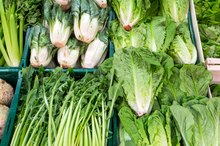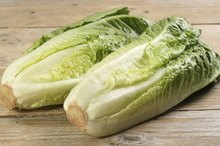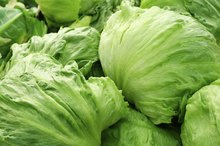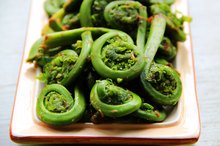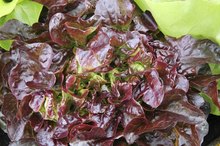What does fact checked mean?
At Healthfully, we strive to deliver objective content that is accurate and up-to-date. Our team periodically reviews articles in order to ensure content quality. The sources cited below consist of evidence from peer-reviewed journals, prominent medical organizations, academic associations, and government data.
The information contained on this site is for informational purposes only, and should not be used as a substitute for the advice of a professional health care provider. Please check with the appropriate physician regarding health questions and concerns. Although we strive to deliver accurate and up-to-date information, no guarantee to that effect is made.
What Is the Nutritional Value of Lettuce?
Lettuce grows well in cool weather and is available in many seasonal varieties. The main types of lettuce are butterhead, crisphead, romaine (also known as Cos), stem (also called asparagus lettuce) and loose-leaf. Leaf lettuce is the best-selling type in grocery stores and also the variety most planted by home gardeners. Crisphead lettuce, more commonly called iceberg lettuce, is widely available in supermarkets. The U.S. Department of Agriculture (USDA) recommends daily consumption of lettuce 2.
Iceberg Lowest in Nutrients
Iceberg is the most commonly available type of lettuce, according to the University of Illinois Extension service (UIE), but it also has the lowest nutritional value 1. The heads with the greenest leaves have the highest nutritional value among iceberg lettuce. The UIE states that these green iceberg leaves also have the best flavor and highest fiber. An experiment conducted in 2003 by the USDA's Agricultural Research Service found that iceberg lettuce showed higher levels of vitamins, calcium and iron, matching romaine and leaf, when the leaves in the iceberg head were kept open during growth. The researchers determined that the "syntheses of these nutrients are light-dependent."
- Iceberg is the most commonly available type of lettuce, according to the University of Illinois Extension service (UIE), but it also has the lowest nutritional value 1.
- An experiment conducted in 2003 by the USDA's Agricultural Research Service found that iceberg lettuce showed higher levels of vitamins, calcium and iron, matching romaine and leaf, when the leaves in the iceberg head were kept open during growth.
Vitamins
What Vitamins Are in Lettuce?
Learn More
Raw leaf lettuce has concentrations of only two vitamins: vitamins C and A. The vitamin A content of one cup of chopped lettuce is 1456 International Units (IU), while vitamin C content is only 13.44 IU. Green leaf varieties with higher vitamins include Black-Seeded Simpson, Grand Rapids and oak leaf. Red leaf varieties include Red Fire, Red Sails and Ruby. Slicing lettuce before use creates an ascorbic acid oxidase that releases vitamin C, and vitamin C content in lettuce is thus destroyed in preparation by many cooks.
- Raw leaf lettuce has concentrations of only two vitamins: vitamins C and A.
- The vitamin A content of one cup of chopped lettuce is 1456 International Units (IU), while vitamin C content is only 13.44 IU.
- Green leaf varieties with higher vitamins include Black-Seeded Simpson, Grand Rapids and oak leaf.
Calcium
A cup of chopped, raw leaf lettuce has 10.16 grams of calcium. The Office of Dietary Supplements at the National Institutes of Health recommends that adults over 18 should consume at least one gram per day of calcium 3. Leaf lettuce is listed on the USDA nutrition chart as a suitable choice for contributing to the daily calcium total.
Potassium and Iron
Nutritional Value of Mesclun Greens vs. Romaine Lettuce
Learn More
One cup of chopped, raw leaf lettuce has over 162 milligrams of potassium and just under 1 mg of iron. According to the Food and Nutrition Center of the Institute of Medicine, adults over 18 should have 4.7 grams of potassium per day. Men over 18 should have 8 milligrams of iron per day, and women 18 milligrams, according to recommendations by the National Institutes of Health 3. The USDA Food Pyramid lists romaine lettuce as a suitable choice for these two dietary requirements.
- One cup of chopped, raw leaf lettuce has over 162 milligrams of potassium and just under 1 mg of iron.
- According to the Food and Nutrition Center of the Institute of Medicine, adults over 18 should have 4.7 grams of potassium per day.
Protein
The USDA lists romaine lettuce under the category of "Dark Green Vegetables" and Iceberg in the "Other Vegetables" category for daily consumption. Even the higher protein count romaine needs twice the amount of lettuce to satisfy the dietary requirements. The USDA chart lists 1 cup of romaine (four leaves measuring 7.5 inches tall and 7 to 11 inches wide) as meeting the half cup dark green vegetable requirement. One cup of raw leaf lettuce (leafy or romaine) includes nearly 1 gram of protein.
- The USDA lists romaine lettuce under the category of "Dark Green Vegetables" and Iceberg in the "Other Vegetables" category for daily consumption.
- The USDA chart lists 1 cup of romaine (four leaves measuring 7.5 inches tall and 7 to 11 inches wide) as meeting the half cup dark green vegetable requirement.
Fiber
The Harvard School of Public Health recommends that “Most adult women should shoot for over 20 grams of fiber a day; men should shoot for over 30 grams." One cup of raw leaf lettuce, either green leaf or red leaf varieties, has 1.3 grams of fiber, according to the UIE, and only 9 calories, making it a quality source of daily fiber.
Related Articles
References
- University of Illinois Extension Service: Lettuce
- U.S. Department of Agriculture: Nutritional Value and Lettuce Head Structure
- National Institutes of Health: Minerals
- Lettuce, iceberg (includes crisphead types), raw. FoodData Central. U.S. Department of Agriculture. Published April 1, 2019.
- How Nutritious Is Iceberg Lettuce?. Berkeley Wellness University of California. Updated 2019.
- Non-Starchy Vegetables. American Diabetes Association.
- Gordon B. How Much Water Do You Need?. Academy of Nutrition and Dietetics. Updated 2020.
- The American Heart Association Diet and Lifestyle Recommendations. American Heart Association. Updated 2017.
- Muñoz-García E, Luengo-Sánchez O, Moreno-Pérez N, Cuesta-Herranz J, Pastor-Vargas C, Cardona V. Lettuce allergy is a lipid transfer syndrome-related food allergy with a high risk of severe reactions. J Investig Allergol Clin Immunol. 2017;27(2):98-103. doi:10.18176/jiaci.0110
- Muñoz-García E, Luengo-Sánchez O, Moreno-Pérez N, Cuesta-Herranz J, Pastor-Vargas C, Cardona V. Lettuce allergy is a lipid transfer syndrome-related food allergy with a high risk of severe reactions. J Investig Allergol Clin Immunol. 2017;27(2):98-103. doi:10.18176/jiaci.0110
- Fontenot K, Johnson C, Williams B, et al. Lettuce. Vegetable Gardening Tips. Louisiana State University Agricultural Center. Updated 2014.
- Smith P, Polomski B, Shaughnessy D. Lettuce. Clemson Cooperative Extension Home & Garden Information Center. Updated 2017.
Resources
Writer Bio
David B. Ryan has been a professional writer since 1989. His work includes various books, articles for "The Plain Dealer" in Cleveland and essays for Oxford University Press. Ryan holds degrees from the University of Cincinnati and Indiana University and certifications in emergency management and health disaster response.
